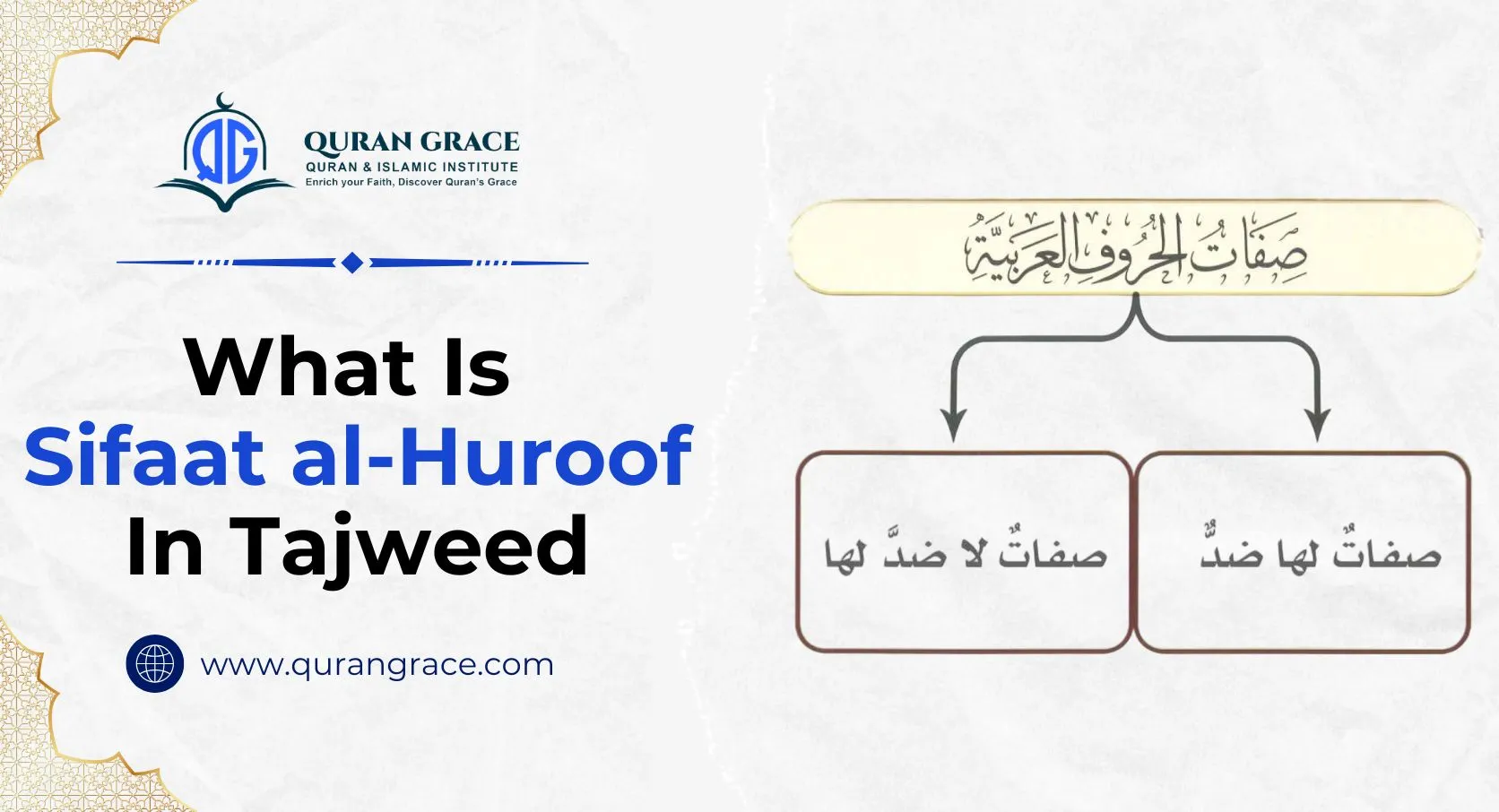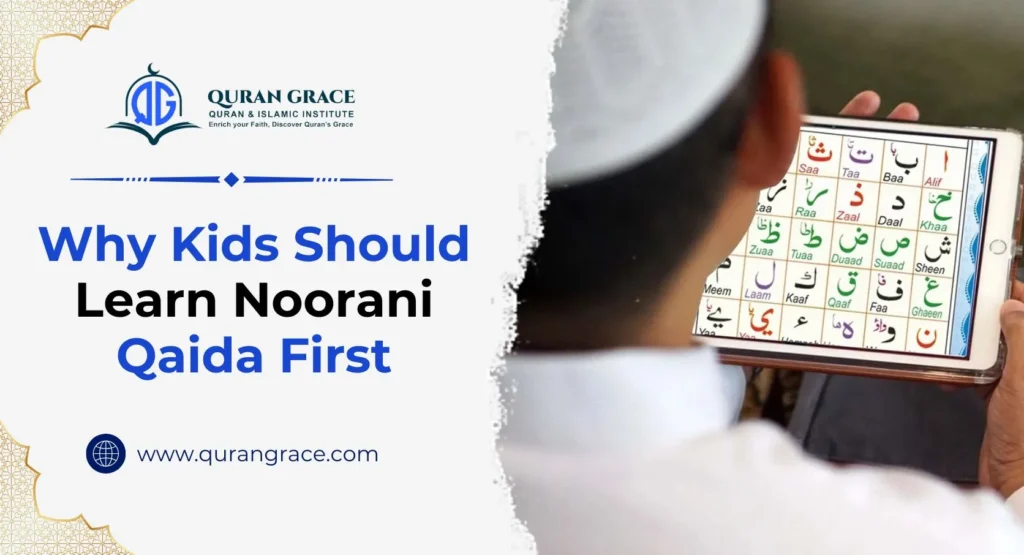Reciting the Quran with impeccable pronunciation relies on understanding the attributes of Arabic letters, known as “sifat ul huroof.” This term translates to “the qualities of the letters.” To recite the Quran accurately with Tajweed, it is essential to grasp the concept of Sifaat in Tajweed. In this discussion, we will explore the meanings and categories of Arabic letter attributes and how they influence exceptional Quran recitation.
Table of Contents
ToggleWhat is Sifat?
In the Arabic language “sifat” refers to the characteristics or qualities of something. The realm of Tajweed, specifically pertains to the properties of Arabic letters and how they are articulated during recitation.
What are Huroof?
The term “huroof” translates to “letters” in Arabic. The language comprises 28 essential letters found in the Quran, which are crucial for precise recitation.
Types of Sifaat ul Huroof
The siffat ul Huroof can generally be classified into two main categories:
- Basic Sifaat
- Optional Sifaat
1. Basic Sifaat
These are inherent traits that must be observed when pronouncing words correctly. Key examples include:
- Al-Jahr: This attribute distinguishes between voiced and unvoiced letters. Voiced letters, like “ب” (b), produce sound, while unvoiced letters, such as “ت” (t), remain silent.
- Al-Hams: This quality refers to the airy sound emitted by certain letters, such as “ف” (f) and “ه” (h). When pronounced, these letters allow air to flow continuously, creating a soft sound.
- Al-Isthalaq: Known as retraction, this attribute involves the tongue shifting back while articulating specific letters. This quality is particularly important for letters like “خ” (kh) and “غ” (gh).
- Al-Qalqalah: This feature occurs with certain letters, like “ق” (q), “ط” (t), “ب” (b), “ج” (j), and “د” (d), where a bouncing sound is produced. These letters generate a distinct echoing effect when pronounced with a sukoon.
By understanding these qualities, one can enhance their Quran recitation and ensure a more accurate and beautiful delivery.
2. Optional Sifaat
These guidelines aren’t strictly required, but incorporating them into your recitation can greatly enhance its tone and flow.
Al-Ibham: This quality involves creating a soft, indistinct sound that can elevate the recitation experience.
Al-Rikhawah: This attribute of softness means pronouncing certain letters with extra care, which can lead to a more beautiful delivery.
Al-Tashdid: This practice focuses on emphasizing doubled letters, requiring the reciter to put in more effort during pronunciation.
Note: To master Sifaat al-Huroof and the other important tajweed rules, you can join online Tajweed classes by Quran Grace and excel in Quran recitation like a pro-Qari.
Al-Jahr vs. Al-Hams
The Whisper (Al-Hams): This refers to the airflow produced when articulating specific letters. The ten letters involved are: ف, ح, ث, ه, ش, خ, ص, س, ك, ت. When pronouncing these letters, especially with a sukoon (absence of a vowel), a gentle airflow continues after articulation.
For instance:
- الرَّحْمَنِ
- بِاسْمِ
Al-Jahr: Commonly referred to as “The Loud Voice,” indicates a halt in airflow.s category contains the following letters:ا, ب, ج, د, ذ, ز, ض, ط, ظ, ع, غ, ق, ل, م, ن, و, ء, ي. When spoken, the articulation of these letters instantly stops the breath.
For instance:
- الحَمْدُ
- ,يُؤْمِنُونْ
Al-Baynya (البَينية), Ar-Rakhawa (الرَّخَاوَةُ), and Ash-Shidda (الشِّدَّةُ)
The Ash-Shidda, or Intensity, is a characteristic that characterizes how the sound ends when the letter is spoken. It pertains to letters with abrupt sound stops, such as ت, ك, ب, ط, ق, د, ج, أ.
انشَقَّتِ Al-Baynya (Intermediate Sound): This group includes letters like ر, م, ع, ن, and ل, where the sound is neither entirely continuous nor interrupted.
In contrast, these letters (و, ·و, ه, ف, غ, ظ, ض, ص, ش, س, ز, ذ, خ, ح, ث, ا) allow the sound to continue smoothly and gently during the pronunciation of Ar-Rakhawa (The Flexibility).
Comparing Al-Istifal (الاسْتِفَالُ) and Al-Istiala (الاِسْتِعَلاءُ)
Since these letters push upward on the palate, they are referred to as emphatic letters. They produce a heavy, high-pitched sound.
Al-Istifal (Lowering): This group includes the other letters. Because the tongue presses downward in this instance, the sound is lighter. ظ, خ, ص, ض, غ, ط, ق
Al-Infitah (الإِنْفِتَاح) vs Al-Itbaq (الإِطْبَاق)
Al-Itbaq explains how to pronounce a word by pressing the tongue against the palate. This property can be seen in letters like ظ, ط, ض, ص.
Al-Infitah, on the other hand, separates the tongue and palate to produce a lighter sound.
Al-Ismat (الإِصْمات) vs Al-Idhlaq (الإِذْلاقُ)
Al-Idhlaq refers to letters that are pronounced smoothly and easily (ب, ل, م, ن, ر, ف), while Al-Ismat refers to the remaining heavier letters that require more effort to speak.
As-Safeer (الصَفِير)
This trait is characterized by the use of a whistling sound to mimic natural sounds, such as cicadas chirping or bees buzzing when pronouncing letters like ص, ز, and س.
Al-Qalqalah, القَلْقَلَة
Qalqalah is the name given to the small echo or bounce that occurs when the words ق, ط, ب, ج, and د are articulated while holding a sukoon. The position of a letter within a word or sentence affects how loud the sound is.
Al-Leen
Finally, Al-Leen is a soft sound feature that applies to noon sakin and tanween when they are followed by a fatha (ـَ) and have a sukoon. Pronouncing the word is made easier by its smooth, gentle tone.
Every one of these qualities is necessary for Tajweed, which provides accurate pronunciation and preserves the class of the Arabic language.
Benefits of Knowing Sifaat
- Mastery of Sifaat leads to accurate pronunciation and authentic recitation.
- Knowledge of letter qualities deepens understanding of quran tajweed rules.
- Proper recitation enriches the spiritual experience with the Quran.
- Awareness of Sifaat helps prevent pronunciation errors that could alter meanings.
- Understanding Sifaat boosts confidence, encouraging consistent practice and improvement.
Overall, grasping the Sifaat of Arabic letters is invaluable for anyone who wants to recite the Quran beautifully and accurately.
Conclusion
We can’t negate the importance of sifaat al-huroof in Tajweed for clear and accurate Quran recitation. Understanding the characteristics of Arabic letters enhances pronunciation and strengthens the spiritual bond with the Quran. Aspiring reciters are encouraged to study and perfect these features, and enrolling in an online Quran recitation course, like those offered by Quran Grace, can help improve recitation skills and connection to the Quran.








